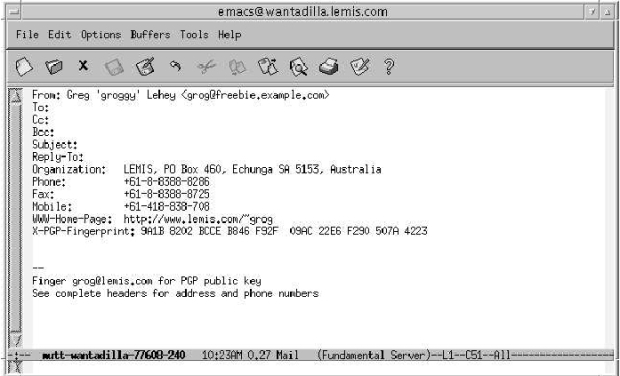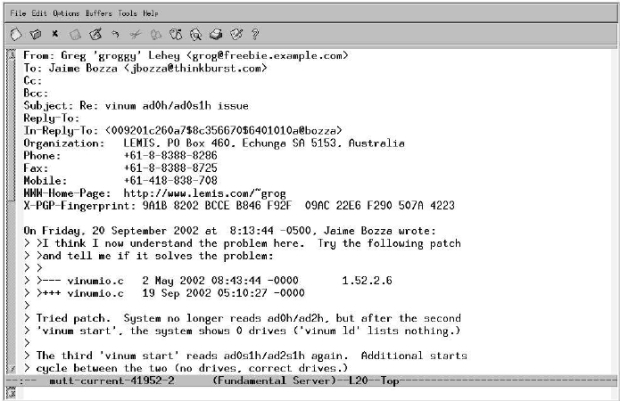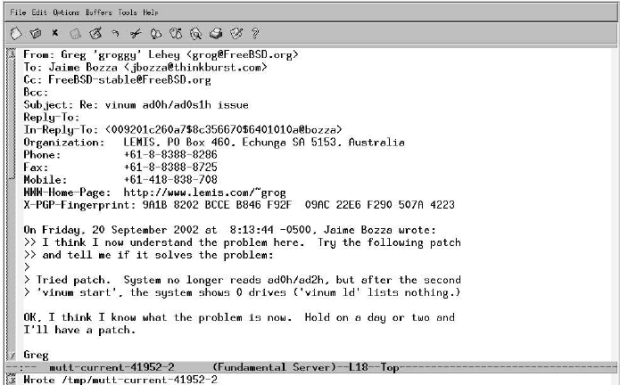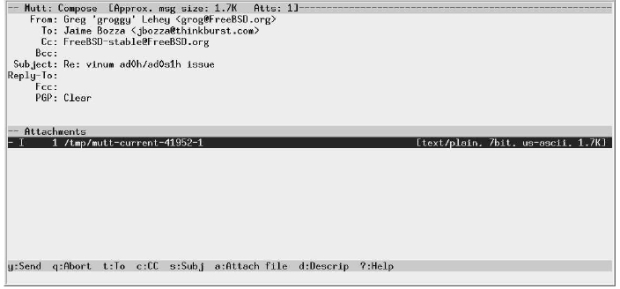| Узбекистан, Бухара, Бухарский институт высоких технологий, 2013 |
Electronic mail: clients
Creating a new message
To create a new message, press m. mutt starts your favorite editor for you. How does it know which one? If you specify the name of the editor in your .muttrc file, or set your EDITOR environment variable to the name of your editor, it starts that editor; otherwise it starts vi. On page 481 we'll look at what to put in .muttrc.
In this case, we start emacsclient. emacsclient isn't really an editor at all: it simply finds an Emacs process and latches on to it. This is much faster than starting a new instance of Emacs: it's practically instantaneous, whereas even on fast modern machines, starting Emacs causes a brief delay. To exit the client, you use the key combination c-x c-#.
Fill out the name of the intended recipient in the appropriate place, and enter the text of the message below the headers, leaving one line of space. Apart from this, most of the actions involved in sending a new mail message are the same as those in replying to an existing message, so we'll look at both activities together in the next section.
Replying to a message
To reply to a message, in this case the message shown in Figure 26-3 , simply press r. Before entering any text, the editor screen looks like Figure 26-5 .
You'll notice that mutt automatically "quotes" the text. The original text started with:
>I think I now understand the problem here. Try the following patch
>and tell me if it solves the problem:
>
>--- vinumio.c 2 May 2002 08:43:44 -0000 1.52.2.6
>+++ vinumio.c 19 Sep 2002 05:10:27 -0000
Tried patch. System no longer reads ad0h/ad2h, but after the second
'vinum start', the system shows 0 drives ('vinum ld' lists nothing.)
This message itself starts with quoted text, which indicates that it was written by somebody else. There should be a line at the top stating who wrote it, but it's missing here. The text from the submitter starts with Tried patch. When you reply, however, all this text is quoted again. The first line attributes the text below. You'll notice that this reply also includes a selection of headers for the outgoing message. This can be very convenient if you want to tailor your headers to the message you're sending, or just to add other recipients.
This is a reply to a technical question, so I change the From: header to my FreeBSD.org address and copy the original mailing list. I also remove irrelevant text and add a reply, as shown in Figure 26-6. It wasn't necessary to reformat the original text, since it was relatively short. The quoting method makes lines grow, though, and many MUAs have difficulty with long lines, so it's a good idea to reformat long paragraphs. See http://www.lemis.com/email.html for more details.
In this example, I reply with the r (reply to sender) command. I could also do a group reply with the g key, which would include all the original recipients, so it wouldn't be necessary to add the mailing list again.
Next, I leave the editor with c-x c-# and return to the screen in Figure 26-7 . Here I have another opportunity to change some of the headers before sending the message. You'll note what seem to be a couple of additional headers in this display: PGP and Fcc:. In fact, they're not headers at all. PGP states what parts of the message, if any, should be encrypted with pgp or gpg. In this case, Clear (the default) means not to encrypt anything.
Fcc: is also not a header. It specifies the name of a folder in which to save the outgoing message. We'll look at folders in the next section.
After making any further changes to the headers, I send the message with the y command, after which I return to the previous display.





